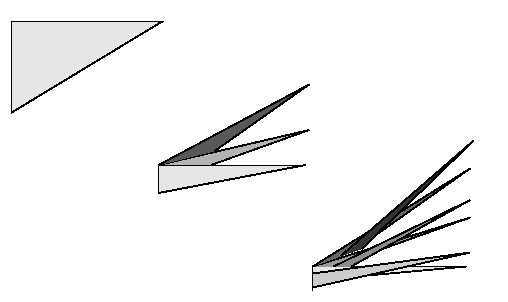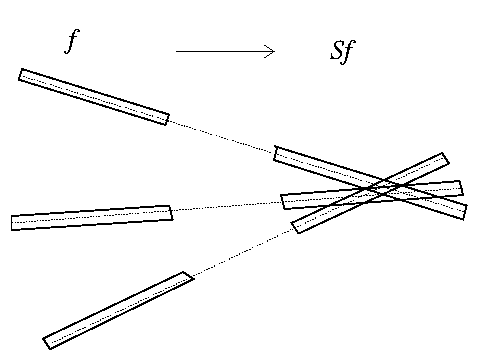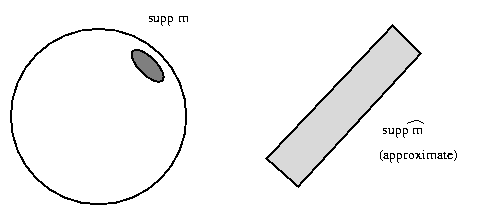The Kakeya problem, and connections to harmonic analysis
What is a Kakeya set?
Questions in harmonic analysis
The Kakeya conjecture
Further reading etc.
This page is meant to provide a very brief introduction to the Kakeya
problem and some related questions. It was first posted in January 2001,
and I expect that it will be evolving
over time. For one thing, I will update it if further progress is
made on the Kakeya conjecture. Also, I may include: descriptions of
other problems, either related directly to Kakeya or just similar in
spirit; more details about some of the ideas and methods involved;
additional links, references, etc.
If you have any comments or suggestions regarding this page, please
write to ilaba@math.ubc.ca.
What is a Kakeya set?
A Besicovitch set is a subset of Rn which contains
a unit line segment in each direction. Besicovitch sets are
also known as Kakeya sets.
Besicovitch sets have an interesting history. In 1917 Besicovitch was
working on a problem in Riemann integration, and reduced it to the
question of existence of planar sets of measure 0 which contain a
line segment in each direction. He then constructed such a set, and
published his construction in a Russian journal in 1920.
Due to the civil war and the blockade, there was hardly any communication
between Russia and the rest of the world at the time. (I was rather
surprised to hear that anybody could be bothered to publish mathematical journals
in Russia in 1920! But this is what Besicovitch says in Amer. Math.
Monthly 70 (1963), 697-706.) Thus
Besicovitch did not know that a Japanese mathematician Kakeya had asked,
also in 1917, a somewhat related question: what is the smallest area
of a convex set within which one can rotate a needle by 180 degrees
in the plane? Pal (1921) resolved that problem (the convex set
should be an equilateral triangle); the more interesting question, without
the convexity assumption, remained open. Besicovitch was told of
all this several years later, after he left Russia. By modifying
his original construction, he gave the surprising answer that the area in
question must of course be positive, but (with a lot of patience)
may be made arbitrarily small. His solution was published in 1928.
Many other ways to construct Besicovitch sets of measure
zero have since been discovered (Perron, Schoenberg, Kahane,...).
Most of them rely on the idea illustrated below. Essentially, we slice
a triangle into many thin subtriangles, and
then rearrange the latter so that they overlap a lot.
If one does this carefully and then takes the limit as the
number of subdivisions goes to infinity, one gets a Besicovitch set of
measure 0 in the plane. Straightforward product techniques extend
the construction to higher dimensions.

Questions in harmonic analysis
Kakeya sets (as well as a closely related construction due to
Nikodym, 1927) have long been used to construct various counterexamples
in analysis, starting with that Riemann integration problem considered
by Besicovitch in 1917. Here I'm only going to describe two central
problems in harmonic analysis - the restriction and Bochner-Riesz
conjectures - which seem to depend on just how small Kakeya sets
can really be. There are many other open problems in analysis,
as well as PDE and number theory, involving Kakeya sets. (See the
references in the "Further reading"
section for more info.)
1. Convergence of Fourier series.
In 1971, C. Fefferman used Besicovitch sets to construct a counterexample
to the ball multiplier conjecture, which concerned a very basic
problem in harmonic analysis. Let f be a function in
Lp(Rn), and let F
be its Fourier transform. If SR f ( x ) is the integral
of F(k) exp(2 \pi i k x) over |k| < R, do
SR f converge to f in Lp as
R goes to infinity? It has long been known that
Lp convergence holds for p = 2, and fails for
p = 1 or infinity, in all dimensions.
An old theorem of M. Riesz says that in dimension 1 the answer is yes
for all finite p > 1, and a higher-dimensional analogue was
generally expected to be true. However, Fefferman proved that in
dimensions > 1 convergence fails for all p other than 2!
Fefferman's argument showcases a beautiful interplay between multidimensional
Fourier analysis and Euclidean geometry. Here is how it goes.
The problem is equivalent to checking whether the disc multiplier
operator, which we will call S, is bounded on
Lp(Rn).
It now suffices to find functions f in
Lp(Rn)
such that the Lp norms of Sf are large.
Fefferman does this by letting f be a sum of characteristic
functions of long and thin tubes, multiplied by appropriate phase factors.
It turns out that S essentially shifts each tube by a fixed
distance in the "long" direction. Now suppose that the shifted tubes
form something close to a Kakeya set; then the support of Sf
is small, and so by Holder's inequality its Lp norm
is large.

Now the disc multiplier question can be rewritten as follows. Let f
and F be as above, and let g(k) be the characteristic funtion
of the unit ball; does the inverse Fourier transform of F(k) g (k/R)
converge to f in Lp(Rn)
as R goes to infinity?
Fefferman's result says that it is always so only for p=2. Yet if
we let g to be e.g., a Gaussian instead, then the answer is yes
for all finite p > 1 - this is the standard textbook proof of the
Fourier inversion formula. So what happens if g(k) is somewhere
in between? Where exactly does convergence start to fail?
The Bochner-Riesz conjecture, which looks essentially like
a "regularized" version of the disc multiplier conjecture, deals with
exactly this question. It is generally regarded as one of the
major unsolved problems of harmonic analysis. (See Stein's book
for a comprehensive discussion.) It turns out that
Fefferman's construction would provide a counterexample to
the Bochner-Riesz conjecture, if one could construct a
Besicovitch set in Rn of Hausdorff
dimension less than n. We will have much more to say about
the latter question later on.
2. The restriction problem.
Let f be a function in
Lp(Rn), can we say
anything intelligent about the restriction of the Fourier
transform of f to a lower-dimensional subset E of
Rn? If E is a hyperplane, then
we can't - the Fourier transform of f does not even have
to be defined on E. But if E is a curved surface,
for example a sphere, then things are a bit different. There
are deep results, due to Stein, Tomas, Fefferman, Bourgain,
Wolff, and others, which say that for certain values of p
and q the Fourier transform of f
is actually in Lq(E). However, what has
been proven is still quite far from what is being conjectured.
Again, the n-dimensional geometry plays a major role,
and there is a point at which Kakeya sets become crucial
(this time, via the uncertainty principle).
Here is, very roughly, why. Let E=Sn-1
be the unit sphere. By duality, the restriction
problem is equivalent to estimating the Lq' norm
of the Fourier transform of measures supported on the sphere.
Let m be such a measure concentrated on a very small spherical
cap of diameter r. By uncertainty principle, its Fourier transform
is essentially constant on a tube of length r-2
and diameter r-1, pointing in the direction
perpendicular to the cap. Multiplying our measure m by
a suitable phase factor, we can place this tube anywhere we like
in the Fourier space.

Now consider the sum of a large number of such measures, multiplied
by phase factors chosen so that the corresponding Fourier tubes
form an approximate Kakeya set. As in the disc multiplier
argument, the Fourier transform of the whole thing has small
support and therefore large Lp norms.
The restriction and Bochner-Riesz problems have long been known to
be connected (e.g., partial results on both problems would often
follow from the same oscillatory integral estimate). One can trace
relevant research back to the 1930's, perhaps further.
Many significant contributions are due to Stein, Calderon, Zygmund,
Carleson, Sjolin, Fefferman, Hormander, Tomas, Cordoba, Christ,
Sogge, Carbery, Bourgain, Wolff, Moyua, Tao, Vargas, Vega,...
And it doesn't look like we'll be done with it any time soon.
The Kakeya conjecture
The problem below looks like geometric measure theory. The motivation for
studying it comes from harmonic analysis, analytic number theory,
and PDE. And the techniques used to prove the partial results
stated below are mostly geometrical and combinatorial, additive
number theory being the latest addition. It is generally expected
that ideas from other, seemingly unrelated, fields of mathematics
will be needed to finally resolve the problem. Anyone looking for
opportunities for interdisciplinary research?
Conjecture. A Besicovitch set in Rn
must have dimension n.
Naturally, one can ask what I mean by "dimension". There
are several, not quite equivalent, definitions - those of interest
to us are the Hausdorff and Minkowski dimension. Most mathematicians
know what the Hausdorff dimension is. The Minkowski dimension (of a
compact set) may be defined as follows. Let Eh
be the h-neighbourhood of E in Rn,
then the (upper) Minkowski dimension of E is the infimum of all
a such that |Eh| < C hd-a
for some constant C. The upper Minkowski dimension of a set is
always greater or equal to its Hausdorff dimension, and there are
examples of sets for which the inequality is strict.
There is also a stronger formulation of the conjecture in terms
of maximal functions. The maximal function statements are
actually quite important, as they are
very closely related to the problems in analysis mentioned above.
This is a bit more technical, though, so we will not go into
it here - at least for now.
The conjecture is known to be true in dimension 2: the Hausdorff (hence
also Minkowski) version was proved by Davies in 1971, and the maximal
function version is due to Cordoba (1977) and Bourgain (1991). In higher
dimensions it is still far from settled. Here is a brief summary of
the best currently known lower bounds.
Since there are no "less-or-equal" and "greater-or-equal" symbols in
HTML, I will use <= and >=.
-
The Minkowski dimension of a Besicovitch set in Rn
is at least 5/2 + 10-10 for n=3 (Katz-Laba-Tao 1999),
3 + 10-10 for n=4 (Laba-Tao 2000),
(2 - 21/2)(n-4)+3 for 4 < n < 24 (Katz-Tao 2001),
and (n + t -1)/t for n >= 24, where t=1.67513... is
the root of t3 - 4 t + 2 = 0 that lies between
1 and 2 (Katz-Tao 2001).
-
The Hausdorff dimension of a Besicovitch set in Rn
is at least (n + 2 ) / 2 for n = 3,4 (Wolff 1994),
and at least (2 - 21/2)(n-4)+3 for n > 4 (Katz-Tao 2001).
Here are some of the ideas that went into proving the above results.
- The bush argument, due to Bourgain. Suppose that the set
E contains a unit line segment in each direction. In order
for E to have low dimension, the segments must intersect a lot.
Hence there are many "high multiplicity" points. Let P
be such a point, then there are many line segments through P;
since all of them go through P, they must be disjoint
otherwise. An appropriate quantitative version of this argument
produces a lower bound on the dimension of E.
I was going to include a picture, but then I found
this
on the Web. It's much better than anything I could come up with.
- Wolff's hairbrush argument is similar in spirit to the
"bush" argument, but one must do the combinatorics a lot more
carefully. Instead of using just one point of high multiplicity,
one finds a line segment L consisting largely of such
points, and computes the volume of the "hairbrush" of all line
segments intersecting L.
Looking at the additive number theory approach (see below), one
might be tempted to regard the hairbrushes as obsolete. But for
the time being, this argument (combined with the additional
geometrical analysis of Laba-Tao) is still the best available
in dimensions 4 to 8.
- Additive number theory arguments, again first used in
this context by Bourgain. (NB: Bourgain's results are not included
in the above list of "world records", as they have been improved upon
by others, but he has contributed more than anyone else towards
understanding Kakeya and its relationship to harmonic analysis.)
Up until now, the philosophy has been to prove that high multiplicity
leads to the occurrence of things like a bush and hairbrush,
consisting of many essentially disjoint line segments and
therefore having relatively large size. In a way, these are
"local" arguments. This is about to change. The new idea is
to prove that if high multiplicity persists throughout our Kakeya
set, it actually forces the set to be very regular
and symmetric - to the extent that many of the line segments
must be parallel. Which of course contradicts the
above definition of Kakeya sets.
To make this kind of reasoning rigorous, one uses something called
inverse additive number theory. Bourgain's argument (improved later
by Katz-Tao) draws on the recent work of Gowers on Szemeredi's
theorem - of particular interest is Gowers's take on the
Balog-Szemeredi theorem, which roughly speaking says that sets with
a small difference set have "structure". For more details,
see the references below.
At first, it didn't seem likely that these techniques could
improve on the hairbrush in low dimensions, in particular in
dimension 3. But Katz-Laba-Tao used geometrical arguments
(including the hairbrush) to "factor out" one dimension
and obtain a setting in which Bourgain's argument is again
effective.
Further reading etc.
If you would like to learn more about Kakeya, here are some
additional links and materials.
There are several recent expository articles on Kakeya and
related topics:
- J. Bourgain: Harmonic Analysis and Combinatorics: How Much
May They Contribute to Each Other?, in Mathematics: Frontiers
and Perspectives, V. Arnold, M. Atiyah, P. Lax, B. Mazur, eds.,
AMS 2000. An overwiev of the problems described above and the
connections between them. Discusses recent work on Kakeya
up to (and including) Bourgain's 1998 paper, but not the developments
that followed.
- T. Wolff: Recent work connected
with the Kakeya problem,
in Prospects In Mathematics, H. Rossi, ed., AMS 1999. This article
was written just a few months too early to include the additive
number theory stuff. Nonetheless, if you are interested in the
subject, you absolutely have to read it. Also includes a discussion
of other problems in combinatorial geometry (Kakeya for circles,
Falconer, Furstenberg, etc.).
- T. Tao: From Rotating Needles to Stability of Waves: Emerging
Connections between Combinatorics, Analysis, and PDE, Notices of
the AMS, March 2001, 294--303. Tao has since posted a
statement
on his web page, with a link to a second (more technical) statement.
If you're like many of the Notices readers who have only a passing
interest in Kakeya, you may well be wondering what the whole mess
is about. I have therefore posted a few
comments and corrections.
Even the title is somewhat misleading. Connections between combinatorics
etc. are not exactly "emerging" - they have been around for quite
some time.
Let's not forget about books.
- E.M. Stein: Harmonic analysis, Princeton University
Press, 1993. Although it obviously does not include the results
obtained after 1993, it is still very much worth reading, just
because its breadth of scope and perspective will not be beaten
any time soon. Don't think of it as an introduction to the subject
- get introduced to it somewhere else. But then do browse through
Stein's book and you will discover plenty of gems that no-one
else seems to remember.
- K. M. Davis and Y.-C. Chang, Lectures on Bochner-Riesz
means, Cambridge University Press, 1987. I'm not sure if
it is still in print. A very nice introduction to restriction,
Bochner-Riesz, and some other related problems in harmonic analysis.
Not as comprehensive as Stein's book, but it does not require
much background and has the advantage of being shorter and
easier to read.
- K.J. Falconer, The Geometry of Fractal Sets, Cambridge
University Press 1985. The general background in geometric measure
theory; includes a detailed discussion of Kakeya sets and some
related problems. Very readable too.
- M. Nathanson, Additive Number Theory: Inverse Problems
and the Geometry of Sumsets, Springer 1996. The background
you might need if you decide to get interested in the additive
number theory approach.
I am also preparing Tom Wolff's Caltech lecture
notes for publication. A revised version should be available
here in a few weeks, and the whole book (including bibliographical
notes etc.) should be finished by the end of the summer.
Last semester I gave a series of lectures at UBC based on Wolff's
notes - many thanks to everyone who attended!
Several people, including
Ben Green
and Terence Tao,
have posted expository Kakeya articles and lecture notes on their
web pages. These are worth checking out, though I don't necessarily
agree with everything they say.
If you need more details, you will have to look up the original
research articles. Many of them are available online from
the Los Alamos preprint archive at
http://xxx.lanl.gov.
They can also be downloaded from the UC Davis server at
http://front.math.ucdavis.edu.
Some time I might look up the links and put them here.
And did I say that there is plenty of ongoing research on these
and related subjects? I will try to keep this page up-to-date
and add new links and references as they appear. :-)
Last updated August 26, 2002.


